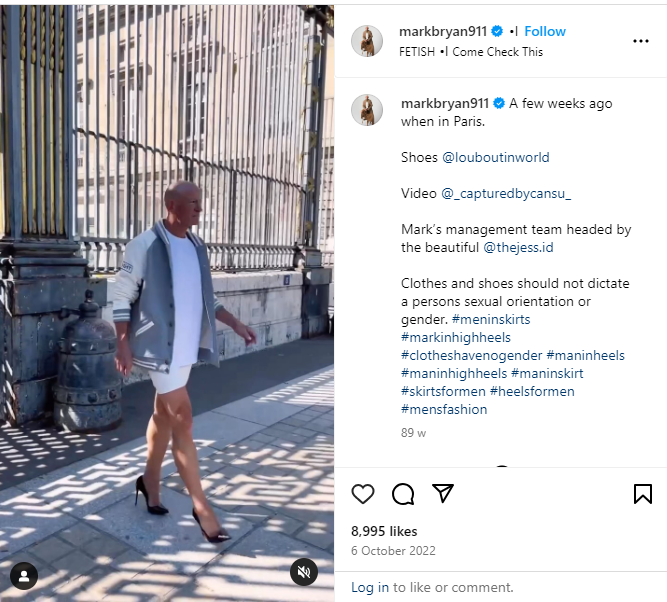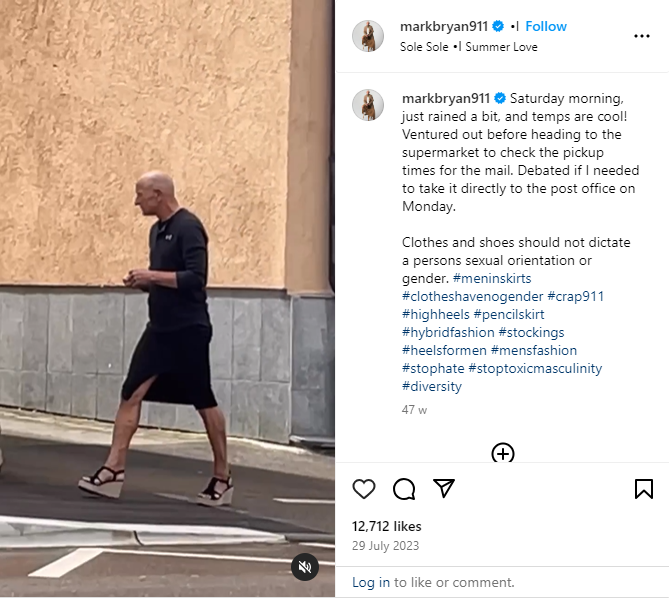
Mark Bryan is a robotics engineer who has been married for 11 years and has a daughter. He identifies as straight and chooses to dress unconventionally. Bryan is an American living in Germany, and he doesn’t believe that fashion has to be gendered. You can find Bryan wearing a skirt and heels to work or out anywhere else he goes on any given day.
Bryan said he doesn’t like how limited men’s choices are in the fashion department, especially when it comes to office attire. Men’s pants only come in a few colors, mostly black, gray, dark blue and the occasional pinstripe, and cuts.
The stylish dresser believes that if women are allowed to wear pants, men should be able to wear skirts and dresses as well. Bryan likes how skirts come in many styles and patterns – and many more colors – unlike men’s clothing.

Bryan prefers to mix traditional gender looks by wearing masculine attire on his top half, like a blazer and tie, and traditionally feminine attire on the bottom half. He will typically wear a pencil skirt and four-inch heels on the bottom.
Wearing high heels is no problem for Bryan. He first learned how to do it when his college girlfriend asked him to wear high heels while dancing with her so that they were on the same level. They continued this for over a year.
Bryan doesn’t let stereotypes or assumptions stop him from dressing in a way that brings him joy. He challenges expectations and does so unapologetically. Keep reading to hear what Bryan has to say about his fashion choices.
Bryan has a very clear idea about how he likes to dress. He told Bored Panda: “To me, clothes have no gender. I prefer skirts to dresses. Dresses don’t allow me to mix the genders. I prefer a ‘masculine’ look above the waist and a non-gendered look below the waist. It’s all about clothes having no gender.”
He continued: “I am old enough to remember that in school, the girls could not wear pants. Pants have now become a non-gendered article of clothing. So why can’t skirts and heels be non-gendered? Besides, men wore heels before women did. Maybe not today’s stiletto-style heels, but men did wear heels before women.”

Bryan is correct about that. High heels can look back on a long history. Although historians and archaeologists cannot date their invention clearly, they have been around at least since the 10th century. And they were not a fashion statement at first. No, the first recorded use of high heels was eminently practical: the Persian cavalry wore boots with heels, called a kalash or galesh, that made it easier for them to keep their feet inside their stirrups. This is, by the way, the same reason why cowboy boots have a small heel as well!
Since owning a horse was a sign of wealth, only well-off men could afford to wear these high-heeled boots. The use of them slowly spread across Europe, and high heels heels became one of the fashion signs of rich noblemen or traders. In fact, following the Great Schism of the Christian Church in the 11th century, even the pope wore high heels.
It wasn’t until several hundred years later that fashion slowly changed. During the 18th century, cultural concerns in Europe came up about the distinction between males and females and talk about what men and women should wear arose. This is the point in time where the belief that fashion is something effeminate and frivolous that “real men” shouldn’t care about hails from. Due to these changing beliefs, men largely abandoned high heels heels, as they were seen as impractical and mere accessories.

Bryan is one of the examples of how high-heels are slowly coming back as an accepted form of footwear for men. Although the engineer champions the option of wearing high-heeled shoes for men, he understands many people will look twice when they see him. He compares his style choices to someone who chooses to dye their hair bright colors. He explained:
“Take a person with bright green hair. Green hair is not normal. You look up and see this person, your mind tells you it’s a person with green hair, you think to yourself, that’s odd or interesting, then you go back to do what you were doing and don’t give it another thought. I believe this is the same when people see me in a skirt and heels.”
Bryan doesn’t have to struggle to find skirts and heels that fit him either. He wears a size 8 in skirts, and with smaller feet for a man, his shoe size in heels is 8.5. If you know a man who is considering trying out wearing heels and skirts too, Bryan suggests starting with a lower heel until you feel more comfortable walking in high heels.
What do you think of Mark Bryan’s style choices? Do you know any men who would try walking in high heels? Let us know, and be sure to send this along to your friends and family.
The Amazing Health Benefits of Ginger

Do you want to know the secret to maintaining great health even as you age? Look no further than ginger! This incredible spice has been used for centuries to boost immunity, improve circulation, enhance brain function, and regulate blood pressure. And the best part? It’s all-natural! If you’ve been including ginger in your diet regularly, it’s no wonder that you’ve been enjoying years of good health.
Boost Your Immunity Naturally
Ginger is packed with antibacterial and antiviral properties that help keep infections at bay. It also reduces inflammation, which is crucial for protecting your body from chronic illnesses. Moreover, ginger cleanses toxins from your system and supports your liver. To make the most of ginger’s immune-boosting benefits, simply enjoy a cup of ginger tea every day.
Take Care of Your Heart
Maintaining a healthy heart is essential, especially as we age. Ginger has been shown to improve circulation and prevent blood clots, reducing the risk of heart-related issues. It also helps regulate blood pressure by relaxing blood vessels and even lowers bad cholesterol levels. For an extra heart boost, try adding fresh ginger slices to warm water or mixing ginger with lemon and honey.
Enhance Your Brain Function
As we get older, it’s important to keep our minds sharp. Ginger can help with that! It improves blood flow to the brain, enhancing focus and clarity. Ginger also protects against memory loss and cognitive decline while reducing stress and anxiety. To give your brain a boost, try blending ginger with turmeric and black pepper.
Take Care of Your Eyesight
Taking care of your eyes is crucial, especially as you age. Ginger is rich in antioxidants that protect the cells in your eyes from damage. It can reduce the risk of cataracts and age-related vision loss while promoting healthy blood circulation to your eyes. To protect your eyesight, consider drinking ginger-infused water or tea on a daily basis.
Soothe Your Digestive System
Digestive issues can be bothersome, but ginger can help! It stimulates digestive enzymes, preventing constipation, bloating, gas, and acid reflux. Ginger is also known to alleviate nausea and motion sickness. Prior to meals, chew on a small piece of fresh ginger or add grated ginger to soups and salads for additional digestive support.
Relieve Joint and Muscle Pain
As we age, joint and muscle pain can become more prevalent. Ginger can be a natural way to reduce inflammation and stiffness in your joints. It’s also helpful for those dealing with arthritis and muscle pain. If you’re experiencing discomfort, try mixing ginger powder with warm water and drink it for relief. You’ll be amazed at the results!
Maintain a Healthy Weight
Maintaining a healthy weight becomes more challenging as we get older, but ginger can help! It boosts your metabolism and aids in burning fat naturally. Moreover, ginger helps control hunger and sugar cravings, preventing blood sugar spikes. For a great start to your day, drink warm ginger tea in the morning to activate your metabolism.
Now that you know the many benefits of ginger, it’s time to make it a part of your daily routine! Whether you enjoy fresh ginger tea, blend ginger with lemon and honey for an immune-boosting shot, or add ginger to your favorite dishes, finding ways to incorporate ginger into your diet is key. It’s no wonder that ginger has kept you healthy, your vision clear, your mind sharp, and your blood pressure normal for all these years. So why wait? Start reaping the amazing health benefits of ginger today and experience the difference it can make in your overall well-being!



Leave a Reply